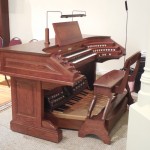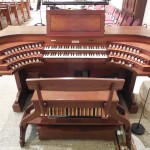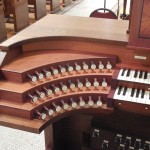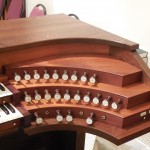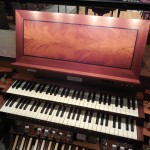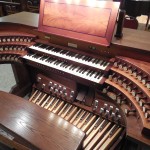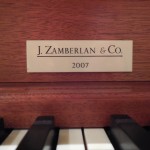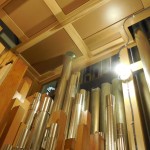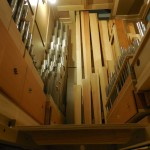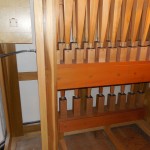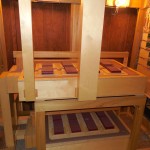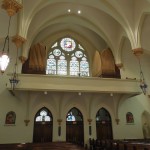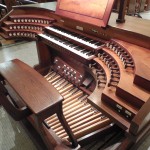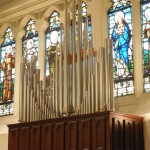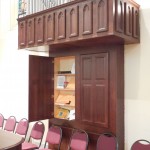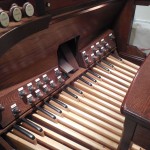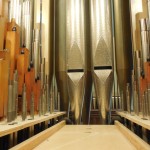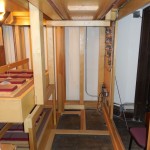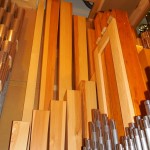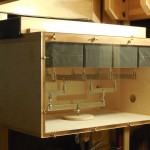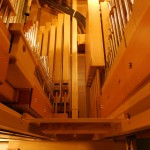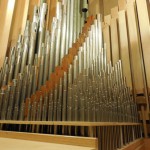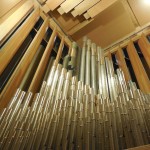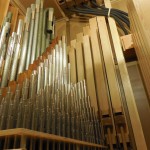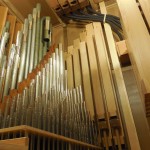Our Opus 3 is located at Christ, Prince of Peace Parish in Ford City, Pennsylvania, and is our largest organ to date. This church had originally been founded as St. Mary in 1888, and the present structure dates from 1912; the parish is the result of the merger, on July 23, 2002, of St. Mary, Holy Trinity and St. Francis of Paola churches. The stone structure is easily visible as one approaches Ford City from several directions, and the interior is elegant in a simple, uncluttered way. The former organ was installed sometime around 1929 (one story is that the pastor bought it from a theater in New York that was unable to pay for it), and had been rebuilt in 1965.
When I first visited the church in September 2002, I found an organ in failing mechanical condition, with difficult access and possessing a thick, tubby and opaque sound. From that beginning, it would take several years of dialogue and proposals before the parish was finally ready to sign a contract. Various possibilities had been discussed — retain the gallery location of the console, locate the console downstairs, have two consoles, provide a “cantor” division behind the marble reredos etc. — but what finally emerged was a two-manual organ with a comprehensive specification, located in the gallery, but with the console downstairs in the “Epistle transept;” although actually cruciform in plan, the transepts are not deep, and the overall feel of the room is more that of a cube than a cross. This location is where the choir was moved to in conjunction with the organ installation, and affords an optimal downstairs location for the singers to project into the entire church.
The old pipe fence and casework (actually rather nice quartersawn white oak) were retained in the gallery, although a new façade is prepared for. Several worthy ranks were reused from the old organ, plus one stop was integrated from the small organ at Holy Trinity as well. Other than those pipes and the blower (which was shipped from Germany to a U.S. supply house in 1989) all parts of the organ itself are new.
One of the possibilities that became incorporated into the final plan was a “Choir” division, located in front of the transept window and, thus, immediately behind and above the choir. This is not a typical organ Choir division in a swellbox, but rather is so named because of its proximity to the singers; its primary purpose is to accompany cantors, although it has proven extremely versatile in leading the congregation for daily Masses, as well as accompanying the choir. These three ranks, with the Bourdon unified at 8’, 4’ and 2’ pitches for a total of five stops, are available independently on either manual for maximum flexibility in registration.
The vast majority of the pipes now stand on slider chests; these are our standard design and construction used in tracker work, but with the addition of pulldown magnets beneath the windbox. We prefer this method because the chest behaves exactly as we’re accustomed to, instead of having an inordinately-large cross-section for the windbox in order to accommodate the magnets; it also permits the manual pulling of notes, if necessary, during tuning and servicing. Channels and pallets were carefully calculated to ensure adequate wind for each pipe with no robbing or sagging, and pallet travel is limited to keep the action responsive. Splitting the chests into C and Cs halves, with the slider solenoids in the middle, automatically provides a convenient perch during tuning, while also making the chests much easier to handle during manufacture and installation and eliminating the need for additional connections for the stop action. It’s interesting to note that the old organ had about 1,200 pipes while the new one has 1,988 (1,790 in the same footprint), yet access for maintenance and tuning is much improved, and the pipes all have sufficient room.
Selected ranks are located on chests with direct valve action, i.e. an electro-pneumatic pouch or a magnetic valve directly below each pipe; this simplifies the duplexing or unification of these ranks, which we always approach cautiously! All pipe holes are properly sized to ensure adequate wind supply to each note, as well as having extra-thick toeboards and a small expansion chamber below each pipe to eliminate undesirable speech characteristics sometimes found in this type of chest design.
As one faces the gallery, the Great and Pedal are on the left, and the Swell is on the right. Each division is housed in a “case” behind the façade, with a thick poplar frame and panels of doubled medium density fiberboard. These heavy panels trap sound within the swellbox when the shutters are closed, yet their hard surface serves to help reflect sound out of the box when the shutters are opened. The shutters are laminated vertical-grain pine for maximum stability, with the opposing edges felted so that an interlocking joint forms when the shutters are closed. The only real difference between each case is that the right side has shutters! The Pedal Subbass / Gedackt is split on the roof of each case, and is arranged carefully so that it’s all but invisible from the floor of the church; this elevated position also helps its sound get to every corner of the room.
All of these tonal resources are controlled from a new two-manual console, with curved, terraced stop jambs. The console shell is constructed of flatsawn red oak, finished to harmonize with the pews, while the interior is made of Honduras mahogany, oiled and waxed as is usual for us.
GREAT (Manual I, C1-a58)
Diapason 8’
Rohrflute 8’ *
Octave 4’
Open Flute 4’ *
Fifteenth 2’
Cornet IV 4’ (c13-c49)
Mixture IV 11⁄3’
Trompette 8’
Cromorne 8’
Choir Gemshorn 8’
Choir Bourdon 8’
Choir Italian Principal 4’
Choir Bourdon 4’ (ext.)
Choir Bourdon 2’ (ext.)
Tremulant
Swell to Great 8’
Swell to Great 16’
Cymbelstern
MIDI
SWELL (Manual II, C1-a58, enclosed)
Quintaten 16’
Violin Diapason 8’ (C1-B12 from Gedackt) *
Gedackt 8’ †
Viole de Gambe 8’ *
Voix Céleste 8’ (from G8) †
Principal 4’
Flute 4’ *
Nazard 22⁄3’
Spitzflute 2’
Tierce 13⁄5’
Plein Jeu III 2’
Cymbale II 2⁄3’
Basson 16’ (ext.)
Hautbois 8’
Choir Gemshorn 8’
Choir Bourdon 8’
Choir Italian Principal 4’
Choir Bourdon 4’ (ext.)
Choir Bourdon 2’ (ext.)
Tremulant
MIDI
PEDAL (C1-g32, AGO)
Bourdon 32’ (indep. resultant and ext.)
Principal 16’ (prep.)
Subbass 16’
Quintaten 16’ (SW)
Octave 8’ (prep.)
Gedackt 8’ (ext.)
Choral Bass 4’ (prep.)
Trombone 16’
Basson 16’ (SW)
Trompette 8’ (GR)
Cromorne 8’ (GR)
Clairon 4’ (GR)
Great to Pedal 8’
Swell to Pedal 8’
MIDI
Great Unison Off
Swell Unison Off
* 1965 Tellers
† 1965 M.P. Moller
